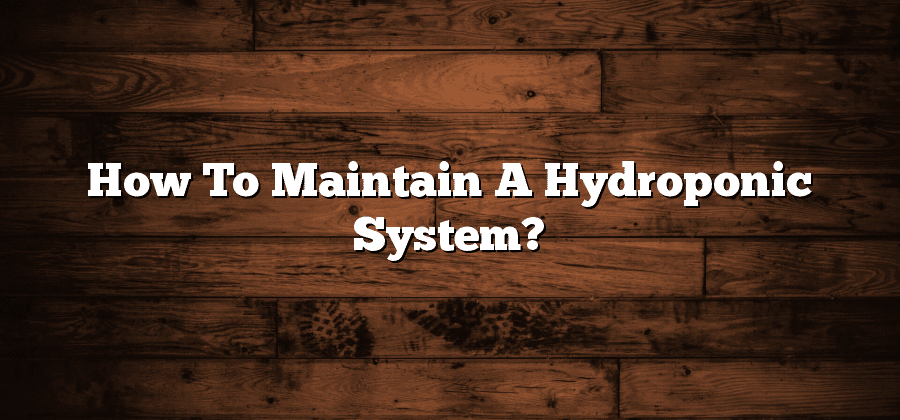Choosing the Right Hydroponic System
When it comes to hydroponic gardening, choosing the right system is crucial for success. With numerous options available, it can be overwhelming to find the best fit for your needs. However, understanding the key factors will help you make an informed decision. Firstly, consider the space you have available. If you have limited room, a compact system like the Nutrient Film Technique (NFT) or Wick System might be ideal. On the other hand, if you have ample space and want to grow a large number of plants, options like the Ebb and Flow System or Deep Water Culture (DWC) are worth considering. Additionally, think about the plants you intend to grow and their specific requirements. Some systems work better for leafy greens, while others are better suited for fruiting crops. By carefully assessing your space and plant needs, you can ensure you choose a hydroponic system that will provide optimum conditions for your plants to thrive.
Understanding Nutrient Solutions and pH Levels
Nutrient solutions and pH levels are crucial elements to consider when it comes to successful hydroponic gardening. These two factors play a significant role in providing plants with the necessary nutrients for healthy growth and development.
Firstly, nutrient solutions are specifically blended mixtures of minerals and nutrients that are dissolved in water and provided to plants via their root systems. These solutions contain the essential macronutrients, such as nitrogen, phosphorus, and potassium, as well as micronutrients like iron, manganese, and zinc. The correct formulation of the nutrient solution is essential to ensure optimal plant growth and production. It is crucial to follow the instructions provided by the manufacturer or consult with a hydroponic expert to determine the suitable concentration of nutrients for different plant species.
Secondly, pH levels refer to the acidity or alkalinity of the nutrient solution. It is vital to maintain the pH within the appropriate range as this directly affects the plant’s ability to absorb nutrients effectively. Different plants have different pH preferences, so it is essential to adjust the pH accordingly to meet their specific needs. Generally, most plants thrive in a slightly acidic pH range of around 5.5 to 6.5. Regular monitoring of the pH levels and making necessary adjustments using pH up or pH down solutions will help prevent nutrient imbalances and ensure optimal plant health. In conclusion, understanding nutrient solutions and maintaining the correct pH levels is of utmost importance to achieve successful hydroponic gardening outcomes.
Monitoring Water and Nutrient Levels
The success of a hydroponic system greatly depends on the careful monitoring of water and nutrient levels. This essential practice ensures that plants have access to the proper amount of hydration and nourishment, resulting in healthy growth and optimal yields. Monitoring water levels involves regularly checking the reservoir to ensure an adequate supply for the plants. It is crucial to top up the water as needed, especially during hot weather or when plants are consuming more water than usual. Additionally, monitoring the pH level of the water is vital to maintain the optimum range for nutrient absorption. Regular pH testing and adjustment will help prevent nutrient lockout or deficiencies, which can hinder plant growth and development.
Similarly, monitoring nutrient levels in a hydroponic system is essential to provide plants with the correct balance of essential elements. Nutrient solutions are the primary source of nourishment for hydroponic plants, and maintaining the appropriate concentration is key to their overall health. Regularly checking the nutrient solution strength using an electrical conductivity (EC) meter allows growers to determine if any adjustments are required. It is important to maintain the right nutrient concentration, as both too little and too much can have negative effects on plant growth. By monitoring water and nutrient levels diligently, growers can ensure that plants receive the necessary resources for optimal growth and vitality.
Managing Lighting and Temperature
When it comes to successfully growing plants using a hydroponic system, managing lighting and temperature is crucial. Adequate lighting is essential for the photosynthesis process, ensuring that plants receive the energy they need to grow and produce healthy crops. It is important to choose the right type and intensity of light for your specific plants, as different plants have different lighting requirements. LED grow lights are a popular choice among hydroponic growers, as they are energy-efficient and can provide the specific light spectrum needed for optimal plant growth. Additionally, maintaining a consistent temperature is important to promote healthy plant growth and prevent the risk of heat stress. Using a thermometer and a thermostat, monitor the temperature levels inside your hydroponic setup regularly and make adjustments as necessary. Creating an optimal environment with appropriate lighting and temperature conditions can significantly improve the success of your hydroponic system and lead to higher yields.
Preventing and Controlling Pests and Diseases
Pests and diseases can wreak havoc on your hydroponic system, compromising the health and productivity of your plants. To prevent and control these unwanted intruders, it is crucial to implement effective strategies. Firstly, maintaining a clean and sanitized environment is key. Regularly clean your growing area, equipment, and tools to eliminate any potential breeding grounds for pests. Additionally, consider using pest-resistant plant varieties and regularly inspect your plants for signs of infestation or disease. Early detection is crucial in preventing the spread of pests and diseases. Implementing a strict quarantine protocol for new plants or equipment can also help minimize the risk of introducing pathogens or pests into your hydroponic system.






